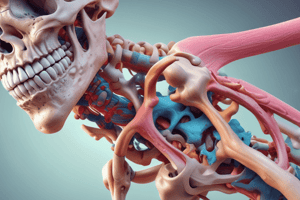Podcast
Questions and Answers
What is a common symptom of Paget's disease?
What is a common symptom of Paget's disease?
- Pain or discomfort in the affected bones (correct)
- Fever and chills
- Visual disturbances
- Nausea and vomiting
Which autoimmune condition is associated with an increased risk of fractures due to bone loss and joint damage?
Which autoimmune condition is associated with an increased risk of fractures due to bone loss and joint damage?
- Systemic lupus erythematosus (SLE)
- Type 1 diabetes
- Rheumatoid arthritis (RA) (correct)
- Celiac disease
What is a common treatment for Paget's disease to manage pain?
What is a common treatment for Paget's disease to manage pain?
- Antibiotics
- Nonsteroidal anti-inflammatory drugs (NSAIDs) (correct)
- Antihistamines
- Antidepressants
What may increase the risk of developing osteoporosis according to the text?
What may increase the risk of developing osteoporosis according to the text?
Which condition might negatively impact bone health if nutrient absorption is compromised due to damaged intestinal villi?
Which condition might negatively impact bone health if nutrient absorption is compromised due to damaged intestinal villi?
What is the primary aim of interventions for osteopenia and osteoporosis mentioned in the text?
What is the primary aim of interventions for osteopenia and osteoporosis mentioned in the text?
Which bone disease is characterized by reduced bone density and impaired bone microarchitecture?
Which bone disease is characterized by reduced bone density and impaired bone microarchitecture?
What is a common symptom of osteoporosis?
What is a common symptom of osteoporosis?
What is a contributing factor to osteoporosis?
What is a contributing factor to osteoporosis?
What is a precursor to osteoporosis?
What is a precursor to osteoporosis?
Which treatment option can help slow down or reverse bone loss in osteoporosis?
Which treatment option can help slow down or reverse bone loss in osteoporosis?
What are some common conditions affecting the skeletal system?
What are some common conditions affecting the skeletal system?
Flashcards are hidden until you start studying
Study Notes
Bone Diseases
The skeletal system, consisting of bones, muscles, tendons, ligaments, joints, and cartilage, plays a crucial role in providing structure, supporting movement, protecting vital organs, and serving as a source of minerals such as calcium. Despite its robustness, various conditions can affect bone strength and functionality, leading to health complications. Some common bone diseases include:
Osteoporosis
Osteoporosis is a progressive condition characterized by reduced bone density and impaired bone microarchitecture, resulting in decreased bone strength and susceptibility to fractures.
Symptoms
- Increased risk of fractures, especially from minor trauma or falls
- Back pain, lost height, and a hunched posture (kyphosis) in severe cases
Causes
- Ageing process reduces bone remodelling rates compared to the accumulation of bone loss
- Certain medications, such as corticosteroids or antiepileptic drugs, can increase the risk of osteoporosis
- Low levels of sex hormones (estrogen in women and testosterone in men), which naturally decline over time
- Poor diet, lack of physical activity, smoking, and excessive alcohol consumption can also contribute to osteoporosis
Treatment
- Calcium and vitamin D supplementation
- Regular physical activity
- Medications such as bisphosphonates, denosumab, and teriparatide can slow down or reverse bone loss
Osteopenia
Osteopenia is a precursor to osteoporosis, characterized by a reduced bone density that has not reached the threshold for a formal diagnosis of osteoporosis.
Symptoms
- No specific symptoms, but individuals with osteopenia are at higher risk for developing osteoporosis and related fractures
Causes
- Similar factors contributing to osteoporosis, such as ageing, medication side effects, or hormonal changes
Treatment
As with osteoporosis, interventions focus on lifestyle modifications and potentially pharmacological management to slow down or arrest bone loss
Paget's Disease
Paget's disease involves abnormal bone remodelling, where the rate of bone destruction and replacement is accelerated.
Symptoms
- Pain or discomfort in the affected bones, which can lead to generalised bone pain
- Weakened bones that may fracture more easily
- Increased warmth in the affected bones or surrounding skin
Causes
- Unknown, although genetic and environmental factors might be involved
Treatment
- Nonsteroidal anti-inflammatory drugs (NSAIDs) to manage pain
- Bisphosphonates to reduce bone turnover and prevent further damage
While these conditions primarily target the skeletal system, it's important to note that certain autoimmune conditions may secondarily affect bone health and increase the risk of fractures. Examples include:
- Type 1 diabetes, which may lead to decreased bone formation and slower bone repair, increasing the risk of osteoporosis
- Systemic lupus erythematosus (SLE), which can cause bone loss through inflammation and reduced bone formation
- Rheumatoid arthritis (RA), associated with increased likelihood of fractures due to bone loss and joint damage
- Celiac disease, which may negatively impact bone health if nutrient absorption is compromised due to damaged intestinal villi
Studying That Suits You
Use AI to generate personalized quizzes and flashcards to suit your learning preferences.




